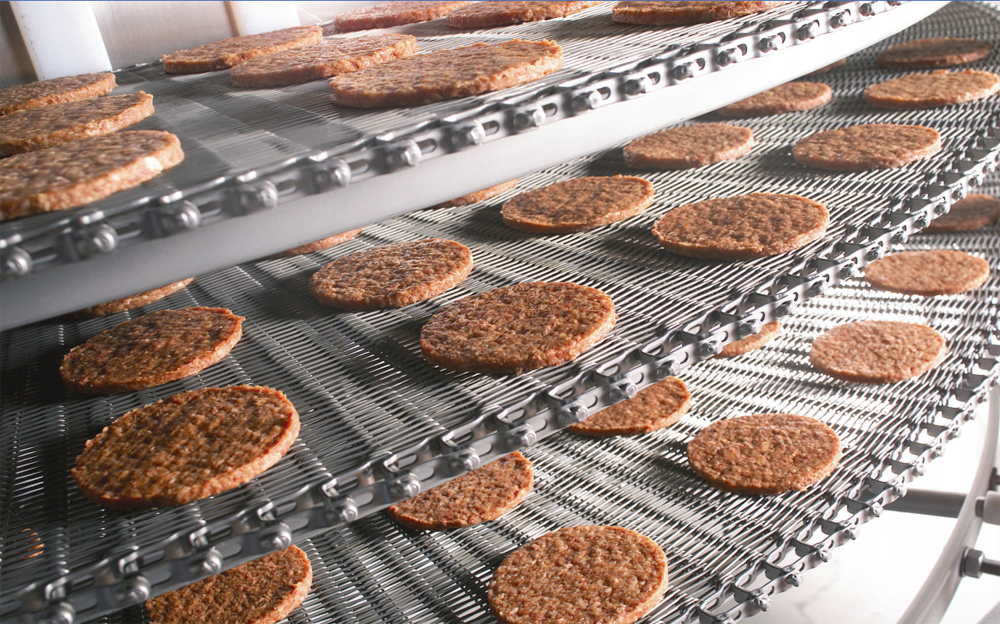
Modern Spiral Freezing – The Science Behind The Process
April 19, 2023What is Spiral Freezing, and Why Is It Important?
Spiral freezers are widely used in the food manufacturing and preservation industry, quickly and efficiently freezing various food products in a safe and effective manner. Spiral Freezers are often the preferred choice among quick-freezing equipment for food processing and storage due to their compact structure, small footprint, high freezing efficiency, and freezing effectiveness.
Spiral Freezers: How They Work
A spiral freezer mechanically transports food products on a continuous spiral conveyor belt through a tightly controlled cooling process that allows the internal freezer temperature to reach as low as -100°C. Spiral freezers are designed to quickly decrease a product’s temperature prior to transporting it or packing it for refrigerated storage. The product to be frozen is moved by a continuous conveyor belt configured in a “stacking” configuration as a series of intertwined spirals, allowing it to constantly expose a much larger amount of product to the cooling process, typically for a longer time than a linear conveyor belt can provide.
Unlike tunnel freezers which require long linear conveyor belts, spiral freezers use stacked, multi-tiered belts to maximize product intake while reducing the necessary area required, saving space and resulting in a smaller footprint for the freezing unit, as well as more efficient freezing. This 360 Degree continuous freezing process ensures that the entire surface of the product is frozen more quickly and evenly.
The intertwined spiral conveyor is also less prone to ice buildup, providing continuous freezing while reducing the need for maintenance and cleanup.
1. Wide Range of Applications
Using a spiral freezer has many advantages for food processing. A spiral freezer can be used for freezing, dehydrating, and cooling. Because of their wide range of applications, spiral freezers are very practical for any food processor. Due to its design and ease of operation, it is very easy to integrate into most food processing systems.
2. Economy of Floor Space
One of the main advantages of spiral freezer systems is that they require little floor space. This makes them ideal for placement under or beside existing equipment and facilities. Spiral freezers may also be placed on storage racks, freeing up much-needed space for other food processing necessities.
3. Customizable Conveyor Speeds
The speed at which a spiral freezer moves can be customized depending on your specific operations and needs. Depending on storage space, volume, or product characteristics, you might need to move products quickly or slowly; spiral freezer systems can accommodate each variable. You’ll be able to maintain efficiency no matter what your production requires.
4. Customizable Temperature Setting
Commercial spiral freezer systems come with different temperature setting options, making it easy to customize your freezing and cooling needs. Food processors can choose from three temperature settings: pre-freezing, freezing, and chilling.
The pre-freezing setting is typically used when preparing foods for storage or transportation while freezing, and chilling temperatures are better suited for long-term storage.
5. High Hygiene Because of Touch-Free Operation
As spiral freezers only touch products when opening and closing, they are very hygienic. Spiral freezers operate with sterilized stainless steel holding trays that do not contact any food. The cold airflow is also germ-free. This means that spiral freezers are perfect for applications where hygiene is paramount.
They Guarantee Better Product Quality
Spiral freezing systems guarantee faster freezing cycles. It translates into exceptional product quality at the end of the processing line. A thorough freezing process secures your products’ surface more efficiently. As such, frozen items retain their essence, original texture, and freshness. The dynamic cooling process kills bacteria and guarantees longer shelf life for your products.
The Science
A parametric analysis comparing the heat transfer and operating characteristics of both tunnel and spiral belt freezers has been carried out using liquid nitrogen sprays under typical commercial freezing conditions. Experimental data were obtained for a controlled spray pressure of 2.4 bar, and two selected pizza sizes (128 and 180 mm diameter) were used based on a freezing capacity of 500 pizzas per hour. The freezing time of the two pizza samples was between 4.1 and 4.4 min in the spiral belt and tunnel freezers, respectively, and appeared to vary directly with sample mass.
The average heat transfer coefficients in the precooling section were 28 and 35 W m−2 K−1 in the tunnel and spiral belt freezers, respectively. These values were about 16 and 15 of the overall heat transfer coefficients in the freezing section, and 116 and 115 of the average heat transfer coefficients of individual droplets, respectively, while maintaining freezer temperature between −140 and −150 °C during freezing. Drip losses were low (0.55 to 0.6%) in both freezer types, and microbial destruction was in the order of six-fold. The mean sensory scores for textural feel of the frozen-thawed samples were not significantly different (P > 0.05), but panelists detected significant differences (P < 0.05) among samples on visual appearance.
—An appraisal of the freezing capabilities of tunnel and spiral belt freezers using liquid nitrogen sprays – Journal of Food Engineering, Volume 34, Issue 2, November 1997, Pages 179-192
Your partners at Advanced Food Equipment LLC. invite you to explore the durability and craftsmanship of the products we offer. We think you’ll agree— AFE is passionately dedicated to providing our customers with the best and most effective long-term equipment options available when anticipating all of your food production needs.
Contact us to work with you in developing your food production strategy today!
